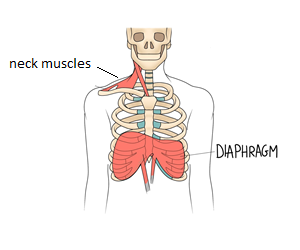February 27, 2023

Written by: Zarmeena Gull (Osteopath at OHC)
Why does my Head Hurt when I Breathe?

The link between a tight diaphragm and headaches might be the reason why you experience headache when breathing in. The reasons and solutions are quite simple, read on below.
Diaphragm – This little muscle is a superstar when it comes to breathing. It’s like the Beyoncé of respiration – it’s always there, doing its thing, and making sure you stay alive. And just like Beyoncé, it can sometimes cause a little bit of trouble.
One of the things that can happen when your diaphragm is working too hard is that it can cause headaches. It’s kind of like when you’ve been singing along to Beyoncé’s greatest hits for too long and you start to get a headache – it’s a sign that you’ve been working too hard.
How Exactly does the Diaphragm cause Headaches?

Well, when you breathe in, your diaphragm contracts and moves downward, creating a space in your chest for your lungs to expand. When you breathe out, your diaphragm relaxes and moves back up, pushing air out of your lungs.
However, if your diaphragm is working too hard, it can cause tension in the muscles surrounding your head and neck. So, if you can imagine something pulling down your lower ribs, you can see how your upper body goes with it. The upper torso starts to round, slumping you forward.
At the same time, the eyes will always try and stay level to the horizon to keep you balanced; So as your torso folds forward, you would expect your head to curl with it, except it doesn’t. Your face & eyes remains looking forward.
TRY THIS: slump down through your tummy, but keep your eyes looking forward… how does that feel though your neck? Pretty jammed through the neck right? This is because there is a fair bit of extension going through your neck, causing your skull to be compressed over the neck joints.
This tension can lead to headaches and even migraines. It’s like when Beyoncé performs a crazy dance routine and you start to feel sore all over – except in this case, it’s your head that’s feeling the pain.
How can I Relax my Diaphragm?

Well, it’s all about pacing yourself. Take regular breaks from activities that require a lot of breathing, like singing or exercising, and make sure to stretch your neck and shoulders to release any tension. If you are in sitting position for too long, again get up and stretch those muscles. Another tip I always give to my patients is to put in a breading/meditation routine in just before going to sleep. Give your body 5-10 minutes of quite breathing time before you sleep. This will also help to regulate the body systems’ and allow the mind and body to relax and unwind, promoting a deeper sleep.
And if you do end up with a headache, try taking some deep breaths to help relax your diaphragm and alleviate the pain.
In conclusion, the diaphragm is an essential muscle that does a lot of important work for our bodies. But just like with Beyoncé, too much of a good thing can sometimes lead to a headache. So, take care of your diaphragm, give it the occasional break, and maybe listen to some Beyoncé while you’re at it. Your body (and your ears) will thank you!
We can Help!
We can treat tension headache by working physically on the diaphragm and releasing the thoracic spine along with releasing first rib attachments. This will increase oxygen to muscles and help reduce stress/ anxiety. This also promotes the quality of sleep as well as improving the digestive system. Like I said, the Diaphragm is a superstar!










